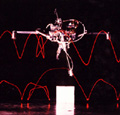 Spring Flamingo
(1996-): Used to study planar bipedal walking. First Leg Lab
robot to use feet and active ankles.
Spring Flamingo
(1996-): Used to study planar bipedal walking. First Leg Lab
robot to use feet and active ankles. We have built a series of legged robots for experiments on active balance in dynamic legged locomotion. Taken collectively, these robots have traversed simple paths, run with several different gaits (hop, run, trot, pace, bound), run fast (13 mph), jumped over obstacles, controlled step length, climbed a simplified stairway, and performed rudimentary gymnastic maneuvers. Although no one robot performed all these tasks, the machines all use a common set of balance and control principles.
 Spring Flamingo
(1996-): Used to study planar bipedal walking. First Leg Lab
robot to use feet and active ankles.
Spring Flamingo
(1996-): Used to study planar bipedal walking. First Leg Lab
robot to use feet and active ankles.
 Spring Turkey (1994-1996):
Used to study planar bipedal walking.
Spring Turkey (1994-1996):
Used to study planar bipedal walking.
 Geekbot (1994-1995): Used to study the smooth transfer of support,
from one foot to the other, during dynamic rocking.
Geekbot (1994-1995): Used to study the smooth transfer of support,
from one foot to the other, during dynamic rocking.
 Planar One-Leg Hopper (1980-1982).
The first Leg Lab robot. It has just one leg with a small
foot. It was designed to explore active balance and dynamic stability in
legged locomotion. It was controlled with a simple three-part algorithm.
The Planar Hopper is shown here jumping over a stack of blocks.
Planar One-Leg Hopper (1980-1982).
The first Leg Lab robot. It has just one leg with a small
foot. It was designed to explore active balance and dynamic stability in
legged locomotion. It was controlled with a simple three-part algorithm.
The Planar Hopper is shown here jumping over a stack of blocks.
 3D One-Leg Hopper (1983-1984):
Built to show that activly balanced dynamic locomotion could be
accomplished with simple control algorithms. It hopped in place, traveled
at a specified rate, followed simple paths, and maintained balance when
disturbed.
3D One-Leg Hopper (1983-1984):
Built to show that activly balanced dynamic locomotion could be
accomplished with simple control algorithms. It hopped in place, traveled
at a specified rate, followed simple paths, and maintained balance when
disturbed.
 Planar Biped (1985-1990): Used to
show that one-legged control algorithms ccould be generalized for
two-legged running, provided just one leg was used at a time. We have used
the planar biped to study locomotion on rough terrain, running at high
speed, and gymnastic maneuvers.
Planar Biped (1985-1990): Used to
show that one-legged control algorithms ccould be generalized for
two-legged running, provided just one leg was used at a time. We have used
the planar biped to study locomotion on rough terrain, running at high
speed, and gymnastic maneuvers.
 Quadruped (1984-1987):
Demonstrated that two-legged running algorithms could be generalized to
allow four-legged running, including the trot, pace, and bound.
Quadruped (1984-1987):
Demonstrated that two-legged running algorithms could be generalized to
allow four-legged running, including the trot, pace, and bound.
 Monopod (1988-1989): Used to investigate simple articulated legs with
rotary joints and a springy foot.
Monopod (1988-1989): Used to investigate simple articulated legs with
rotary joints and a springy foot.
 Uniroo (1991-1993): The first Leg Lab robot patterned loosely after an
animal. It has an articulated leg with the same link length proportions as
a kanagaroo and it has a simple actuated tail.
Uniroo (1991-1993): The first Leg Lab robot patterned loosely after an
animal. It has an articulated leg with the same link length proportions as
a kanagaroo and it has a simple actuated tail.
 3D Biped (1989-1995): Hops,
runs, and performs tucked somersaults.
3D Biped (1989-1995): Hops,
runs, and performs tucked somersaults.
 Planar
Quadruped (1995-1996): An experimental platform for studying the role of an
articulated spine in running.
Planar
Quadruped (1995-1996): An experimental platform for studying the role of an
articulated spine in running.
 Passive
Dynamic Doll (1993-1994): Performs layout somersaults about the
unstable middle principal axis of inertia with stability provided by
passive arm motion.
Passive
Dynamic Doll (1993-1994): Performs layout somersaults about the
unstable middle principal axis of inertia with stability provided by
passive arm motion.
 Zero Gravity Robot (1988): Designed to suggest how one could run in
space, if you had a ceiling in addition to a floor. It bounces between two
walls in a plane while floating on an air table.
Zero Gravity Robot (1988): Designed to suggest how one could run in
space, if you had a ceiling in addition to a floor. It bounces between two
walls in a plane while floating on an air table.